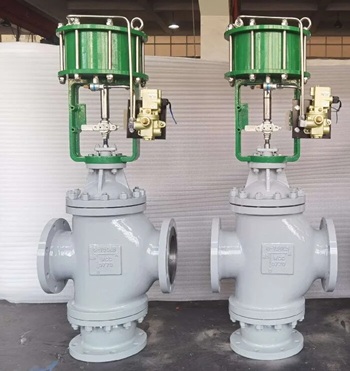


Pneumatic Three-Way Control Valves: Versatile and Precise Flow Management for Industrial Systems
Pneumatic Three-Way Control Valves: Versatile and Precise Flow Management for Industrial Systems
Introduction
Pneumatic three-way control valves play a crucial role in industrial fluid management by efficiently diverting or combining flows of water, steam, gas, and other media. Widely used in heat control systems such as heat exchangers, these heavy-duty valves deliver reliable, precise, and efficient flow control for diverse applications.
The China Control Valves typically feature a compact multi-spring diaphragm actuator, which provides high output and simplifies operation even under high differential pressures. This makes them ideal for both diverting and mixing duties in demanding industrial settings.
Key Specifications
Hysteresis Error:
Without positioner: within 3% F.S.
With positioner: within 1% F.S.
Linearity:
Without positioner: ±5% F.S.
With positioner: ±1% F.S.
These specs ensure consistent accuracy, especially when paired with a positioner.
How It Works
Pneumatic three-way valves use compressed air to drive the multi-spring diaphragm actuator. The valve has three ports—one inlet and two outlets (or vice versa)—enabling it to either divert flow from one outlet to another or mix flows from two inlets into a single outlet.
The actuator converts pneumatic pressure into mechanical motion, moving the valve’s internal parts smoothly and precisely. In heat exchangers, for example, the valve regulates hot or cold media flow to maintain temperature control by diverting or mixing fluids as needed.
Benefits
Versatility: Suitable for water, steam, and gas systems, handling both diverting and combining functions.
Precision: Low hysteresis and high linearity enable accurate flow control.
Durability: Built for high differential pressures and harsh environments.
Compact Design: Lightweight diaphragm actuator eases installation and maintenance.
Energy Efficiency: Optimizes flow control to reduce system energy use.
Ease of Maintenance: Simplified mechanisms reduce wear and maintenance frequency.
Maintenance Tips
Conduct regular inspections for wear or damage.
Lubricate moving parts to minimize friction.
Clean to prevent debris or mineral buildup.
Calibrate valve and positioner to maintain accuracy.
Check and repair leaks promptly.
Replace worn seals or diaphragms as needed.
These practices extend valve life and prevent costly downtime.
Two-Way vs. Three-Way Control Valves
Two-Way Valves: One inlet and one outlet, used for simple on/off or flow regulation in a single direction. They are simpler, cheaper, and easier to install but unsuitable for mixing or diverting.
Three-Way Valves: One inlet and two outlets (or vice versa), designed for mixing or diverting flows. They offer greater versatility and precise temperature control but are more complex and costly.
Choose based on your system’s need for simple flow control versus mixing/diverting functionality.
Applications
HVAC: Regulate heating and cooling media for optimal climate control.
Heat Exchangers: Maintain desired fluid temperatures via precise flow management.
Industrial Processes: Divert or mix fluids to control production parameters.
Water Treatment: Manage water and chemical flows efficiently.
Steam Systems: Control steam flow for heating or power generation.
Conclusion
Pneumatic three-way control valves are vital for achieving reliable, precise flow control in many industrial sectors. Their robust design, accuracy, and versatility make them ideal for HVAC, heat exchangers, water treatment, and more. Understanding their operation, maintenance, and selection criteria helps ensure optimal performance and long service life.
Investing in quality pneumatic three-way valves is essential for industries seeking efficient, durable, and adaptable flow control solutions in today’s challenging industrial environments. Know more about Google SEO Directory
